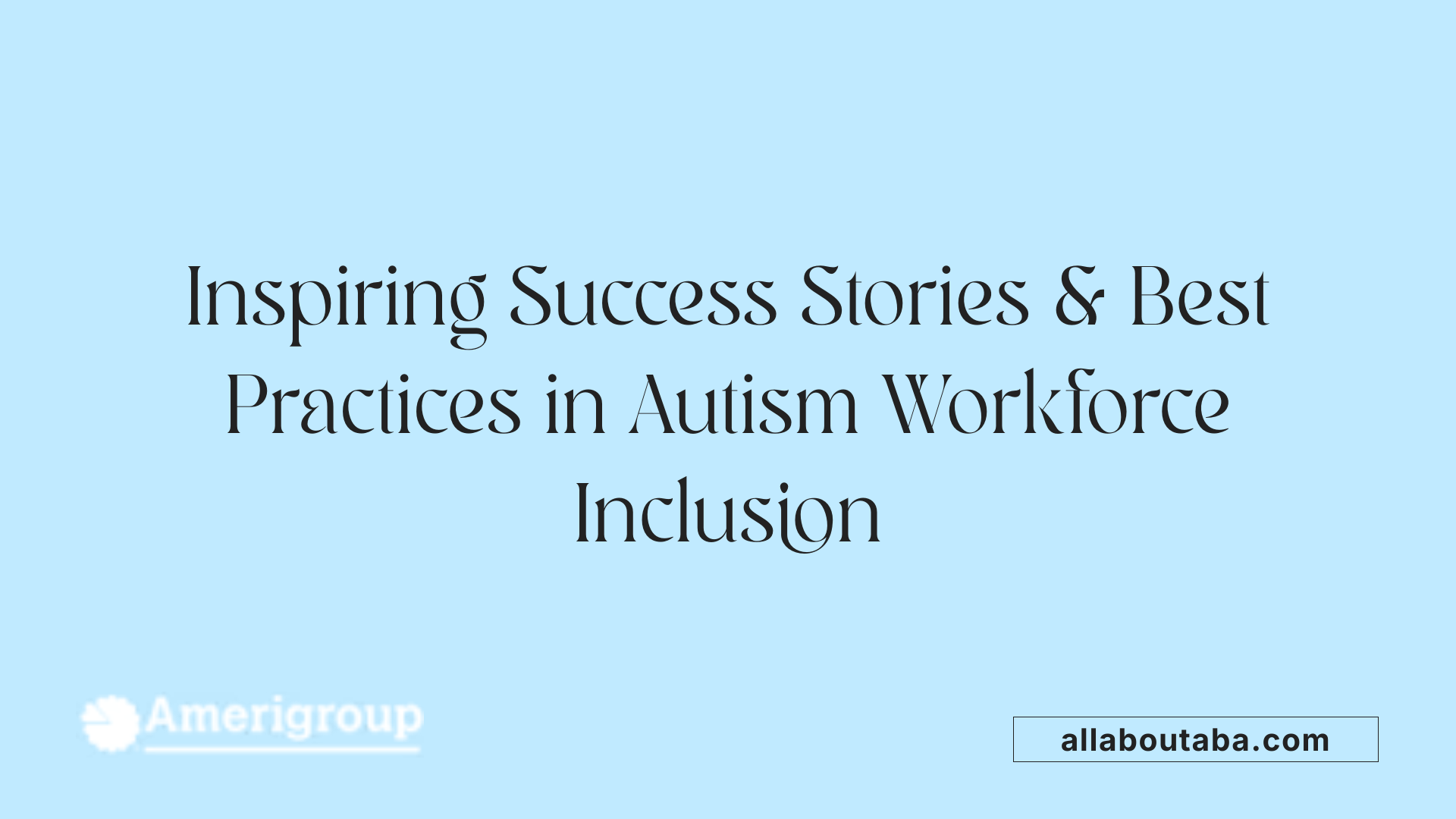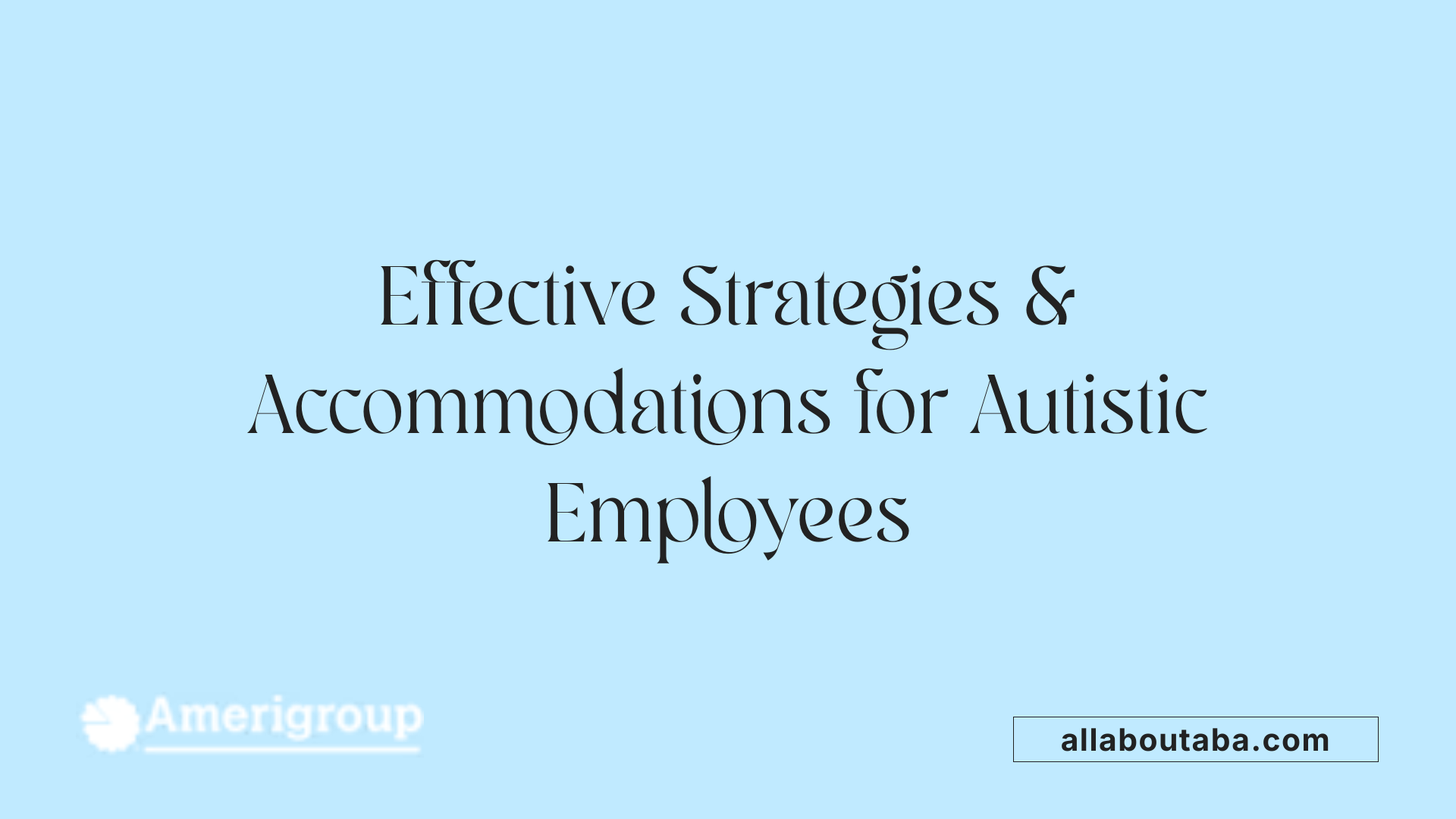Understanding the Landscape of Autism and Employment
Autism Spectrum Disorder (ASD) affects a significant portion of the population, with approximately 1 in 36 children diagnosed in the U.S. The employment rate for autistic adults remains alarmingly low, with only around 19.3% of persons with disabilities employed in 2020, and a notable underutilization of their skills in the workforce. Yet, with targeted support, education, and inclusive practices, autistic individuals can thrive in diverse roles that leverage their unique strengths. This article explores career options, support systems, and best practices aimed at fostering meaningful employment for autistic adults.
Suitable Careers for Autistic Strengths and Interests

What are common employment opportunities and career options suitable for individuals with autism and Asperger's syndrome?
People on the autism spectrum possess a wide range of skills that can be well-utilized in many fields. Many find fulfilling careers in technology, arts, sciences, and skilled trades.
In the technology sector, roles like computer programming, web design, video game design, cybersecurity, and data management are popular options. These jobs often involve structured tasks, clear rules, and measurable outcomes, aligning well with the strengths of many autistic individuals.
The arts also offer promising opportunities. Careers such as commercial art, photography, graphic design, and visual arts allow creative expression and can be adapted to individual preferences. Many individuals with autism excel in visual thinking and pattern recognition, making these fields particularly suitable.
In science and engineering, roles such as laboratory technician, researcher, or engineer benefit from attention to detail, persistence, and systems thinking. These positions often involve structured environments with specific procedures, which can be advantageous.
Skilled trades like welding, plumbing, automobile repair, and factory maintenance are excellent options for those who prefer hands-on work within predictable routines. Jobs in manufacturing and assembly lines are also common choices.
Jobs requiring routine and structured environments
Certain jobs are particularly compatible with individuals who thrive in routine settings and structured tasks. These include roles like data entry, library services, warehouse work, janitorial jobs, plant care, and recycling plant activity.
These positions often involve repetitive tasks and minimal need for fast processing of information, which suits individuals with challenges in short-term working memory but strengths in long-term memory and visual thinking.
Support programs play a crucial role in helping autistic individuals prepare for and succeed in these careers. Initiatives such as Autism@Work, Hire Autism, and the Neurodiversity Career Connector provide pathways, training, and resources tailored to their needs.
Support programs connecting to employment opportunities
Organizations like the Autism Society and local vocational rehabilitation agencies facilitate connections between job seekers and employers. Supported employment services promote inclusive workplace practices examining the Four Pillars of Belonging: Acceptance, Access, Dignity, and Excitement.
These programs aim to create workplaces where autistic employees are valued, provided accommodations, and have opportunities for advancement. They also focus on community engagement and multi-agency collaborations to improve employment rates.
Employment options are diverse, including full-time roles, part-time work, internships, volunteer positions, and mentorship programs. The goal is to match individual strengths with suitable career pathways, helping individuals achieve independence, fulfillment, and economic security.
Employment statistics and the importance of inclusive practices
Despite the potential, only about 30% of autistic individuals disclose their condition at work, and unemployment remains high—up to 85% of college-educated autistic adults face underemployment.
Addressing this gap involves promoting workplace acceptance, providing relevant training, and ensuring equitable opportunities. Businesses that embrace neurodiversity report increased innovation and problem-solving capabilities.
Diverse career paths leveraging autism strengths
Autistic individuals can thrive in fields like AI & Software Engineering, research, accounting, cybersecurity, UX design, manufacturing, and scientific research. The growth outlook for these fields is positive, with increased demand expected through 2033.
Traits such as attention to detail, love of logic, pattern recognition, visual acuity, and systems thinking contribute to success in these roles, creating rewarding career pathways.
Resources and community engagement
Numerous resources support employment for autistic people, including government programs, nonprofit organizations, and employer-led initiatives. Platforms like Autism@Work and Project SEARCH provide job matching, training, and mentorship.
Highlighting successful inclusion cases encourages more companies to adopt inclusive practices, leading to better employment rates and improved quality of life for autistic individuals.
| Sector | Suitable Roles | Typical Tasks | Average Salary Range |
|---|---|---|---|
| Technology | Software Tester, Programmer, Cybersecurity Analyst | Coding, troubleshooting, system analysis | $50,000–$120,000 |
| Arts and Visuals | Photographer, Graphic Designer, Video Game Designer | Creative design, visual storytelling | $40,000–$90,000 |
| Science and Engineering | Laboratory Technician, Research Scientist, Engineer | Experiments, data collection, technical analysis | $60,000–$130,000 |
| Skilled Trades | Welder, Plumber, Automotive Mechanic | Repairing, maintaining, assembling | $30,000–$70,000 |
| Routine Jobs | Data Entry, Warehouse Worker, Library Assistant | Repetitive tasks, sorting, stocking | $25,000–$50,000 |
Supporting inclusive employment not only benefits individuals on the spectrum but also enhances the diversity, creativity, and innovation in the workplace. Fostering understanding and offering accommodations are essential steps toward a more equitable workforce for all.
Leveraging Strengths and Understanding Workplace Challenges
How can individuals with autism leverage their strengths and understand their workplace challenges?
Individuals with autism possess unique talents that, when harnessed properly, can make significant contributions to the workforce. Many excel in roles that involve attention to detail, systematic thinking, and a love of logical problem-solving. For example, careers like data analysis, quality control, system testing, programming, or laboratory work often align well with these strengths.
Recognizing personal challenges is equally important. Common difficulties for autistic individuals include sensory sensitivities, which can make noisy or bright environments overwhelming, and social communication challenges, which can affect interactions with colleagues or understanding unspoken workplace norms.
To succeed, it’s helpful to adopt strategies that address these challenges. Creating sensory-friendly workspaces with noise-canceling headphones or adjustable lighting can reduce sensory overload. Clearly communicating expectations and providing written instructions can help with social and procedural understanding.
Workplaces that are predictable and structured tend to be more accommodating. Regular routines, explicit task guidelines, and the availability of quiet spaces support focus and reduce anxiety. Flexible work arrangements, such as telecommuting or adjustable hours, further assist autistic employees in managing their comfort and energy levels.
Disclosing autism diagnosis is a personal choice, but when done, it can foster understanding and appropriate support. Sharing information about sensory preferences or required accommodations can lead to a more inclusive environment.
Fostering an inclusive workplace culture is vital. Employers can implement diversity training that highlights neurodiversity, promoting acceptance and reducing stigma. Providing ongoing support and training for staff enhances mutual understanding and teamwork.
In summary, by focusing on individual strengths and implementing targeted strategies, workplaces can enable autistic employees to thrive. Supporting accommodations and fostering acceptance not only benefits individuals but also enriches organizations through increased innovation, problem-solving, and diverse perspectives.
Support Systems and Resources for Inclusive Employment

What resources and support systems are available to promote inclusive employment practices for autistic adults?
Ensuring equitable employment opportunities for autistic adults involves a variety of support systems and resources established by government agencies, nonprofit organizations, and community initiatives.
Federal laws play a crucial role in protecting the rights of autistic workers. The Americans with Disabilities Act (ADA) and Section 503 of the Rehabilitation Act require employers to provide reasonable accommodations and promote non-discriminatory practices. These regulations create legal frameworks that encourage accessible work environments.
Organizations dedicated to autism support, such as Autism Speaks, the Autism Society, and Autism@Work, offer tailored employment programs. They develop toolkits, mentorship opportunities, and network-building activities that connect autistic adults with potential employers and support services.
Several initiatives focus on creating inclusive workplace cultures. For example, the Autism Employment Connector Challenge and Autism Speaks’ Workplace Inclusion Now (WIN) initiative promote workforce training through online courses, awareness campaigns, and participation in diversity programs.
Additional resources include the Job Accommodation Network (JAN), which provides employers and employees with guidance on workplace adjustments, from flexible scheduling to sensory-friendly office modifications.
Local vocational rehabilitation agencies and community programs assist with career planning, skills training, and transition-to-work support tailored to individual needs. These programs often include internships, volunteer work, and mentorship programs that promote employment readiness.
Community engagement and multi-agency collaborations are vital in expanding access to employment for neurodiverse populations. Partnerships between educational institutions, employers, and nonprofit agencies help bridge gaps and foster inclusive job environments.
Resources such as the Neurodiversity Career Connector and Hire Autism offer pathways specifically designed for autistic job seekers, including job boards, résumé support, and coaching.
Overall, these collective efforts aim to break barriers, promote acceptance, and support personal and professional growth among autistic adults. They help integrate individuals into the workforce while honoring their unique strengths and needs.
| Resource/Program | Focus Area | Support Offered |
|---|---|---|
| Americans with Disabilities Act | Legal protections | Ensures workplace reasonable accommodations |
| Autism Speaks | Employment programs | Toolkits, mentorship, training, networking |
| Autism@Work | Workplace inclusion | Employer-supported initiatives, online courses |
| Job Accommodation Network (JAN) | Workplace adjustments | Guidance on modifications and accommodations |
| Autism Employment Connector Challenge | Workforce training | Innovation in employment practices, awareness campaigns |
| Hire Autism | Job matching and coaching | Job boards, résumé coaching, interview prep |
| Local vocational rehab agencies | Career transition support | Skills training, internships, personalized employment planning |
By leveraging these resources and fostering collaborative efforts, communities and workplaces can build an environment where autistic adults can thrive and contribute meaningfully.
Success Stories and Best Practices in Autism Employment

Are there success stories or best practices for employing autistic individuals?
Yes, there are many inspiring success stories and established best practices for integrating autistic individuals into the workforce. Organizations that prioritize inclusion and adapt workplaces to meet the needs of autistic employees have demonstrated that meaningful employment is achievable and beneficial.
One well-known example is the TEACCH program, which provides tailored support and training for autistic workers, focusing on visual supports and structured routines. Similarly, Project SEARCH offers internship programs that help young adults with autism transition smoothly into competitive employment through hands-on experience and employer partnerships.
Workplace policies that foster acceptance and flexibility are crucial. Autism Speaks’ Workplace Inclusion Now (WIN) initiative promotes employer education and mental health awareness. These programs emphasize training staff to understand autism, creating sensory-friendly workspaces, and allowing flexible schedules, which can significantly improve job retention.
Autistic adults have contributed notably to fields such as technology—many excel in software development, data management, and design—healthcare, arts, and scientific research. For example, individuals with high-functioning autism or Asperger’s syndrome often show strengths like attention to detail, pattern recognition, and systematic thinking, which are highly valued in these roles.
Creating a supportive environment involves more than policies; it includes providing targeted accommodations. These may involve quiet work areas, visual communication tools, flexible deadlines, and mentorship programs. Such measures not only enable autistic employees to succeed but also enhance overall workplace diversity, creativity, and innovation.
Moreover, the success of these programs is often documented through case studies highlighting the positive impact on both employees and employers. These stories show that with the right support, autistic individuals can be highly productive, loyal, and valuable team members.
In sum, leveraging best practices—such as inclusive policies, tailored supports, and ongoing awareness—can transform workplaces into environments where autistic individuals thrive. This not only benefits the employees but also enriches the organization through diverse perspectives and problem-solving approaches.
Impact of Support and Accommodations
Support systems and accommodations have been shown to be pivotal. They contribute to increased job satisfaction, higher retention rates, and improved performance. For example, flexible work hours can help individuals manage sensory sensitivities and other challenges.
Employers who implement comprehensive onboarding, ongoing training, and mentorship programs tend to Foster a culture of understanding and inclusion.
Furthermore, community engagement and partnerships with organizations like the Autism Society, local vocational agencies, and nonprofit groups amplify the effectiveness of employment initiatives.
Through examples and systemic approaches, workplaces are becoming more accessible and inclusive for autistic individuals, reinforcing the idea that diversity in neurodevelopment enhances any professional environment.
Educational Pathways and Career Development

What educational and career pathway options are available to autistic individuals?
Autistic individuals have a wide range of options to pursue their education and build fulfilling careers. These options include specialized training programs that cater to their unique learning styles and needs, as well as college majors aligned with their strengths.
Many choose fields such as computer science, engineering, arts, and sciences, which often involve structured environments and clear expectations. Vocational education is also highly beneficial, emphasizing practical skills like programming, drafting, animal training, and laboratory work. These programs typically incorporate hands-on training, real-world projects, and workplace simulations, helping students build confidence and competence.
Supportive workplace accommodations are crucial for success. These can include providing clear instructions, sensory-friendly environments, flexible work hours, and predictable routines. Such adjustments enable autistic employees to thrive and demonstrate their talents.
Career options that align well with autistic strengths include roles in technology—like software development and cybersecurity—as well as creative fields such as graphic design, animation, and photography. Many individuals excel in research, data analysis, and skilled trades, where attention to detail and systemizing abilities are valued.
Transitioning into the workforce is supported by multiple resources. Government agencies, nonprofit organizations, and advocacy groups offer guidance, training, and job placement services. For example, programs like Autism@Work, Hire Autism, and the Neurodiversity Career Connector provide pathways to competitive employment.
Furthermore, initiatives promoting inclusive workplaces emphasize the importance of belonging, acceptance, and dignity. These efforts aim to create environments where autistic individuals are fully integrated and have equal opportunities for development and advancement.
In summary, education and career development options for autistic individuals are diverse and adaptable. With the right supports, tailored training, and a focus on strengths, they can access meaningful careers, contribute valuable perspectives, and lead satisfying professional lives.
Strategies for Navigating Employment and Workplace Accommodations

What strategies can be used to navigate employment and maximize workplace accommodations for autistic employees?
Navigating employment as an autistic individual involves proactive communication and a clear understanding of one's needs. Employers can foster a supportive environment by engaging in an "interactive process," a collaborative dialogue that discusses specific accommodations without requiring the disclosure of extensive personal information. This process is essential for tailoring support that aligns with each person’s unique abilities and challenges.
Providing various reasonable accommodations is vital to creating an inclusive workplace. These may include options like flexible work hours to manage sensory sensitivities, sensory-friendly work environments that reduce overstimulation, written instructions to aid memory and task clarity, noise-canceling headphones or devices, and job restructuring to focus on strengths while minimizing demands that are overly stressful.
Legal considerations also play a crucial role. Awareness of the Americans with Disabilities Act (ADA) obligations ensures that accommodations are appropriate and do not impose undue hardship on the organization. Employers must balance the need for support with business operations while respecting the rights of their employees.
A successful strategy goes beyond initial adjustments. Continuous dialogue and regular follow-ups help evaluate whether accommodations are effective and adjust them as needed. Training managers and coworkers about autism can reduce stigma, promote understanding, and encourage a culture of acceptance.
Promoting workplace awareness, implementing targeted training, and fostering an environment of openness contribute significantly to the success of autistic employees. Moreover, providing access to resources, like employment supports from the Autism Society or government programs, can enhance understanding and implementation of effective accommodations.
Ultimately, recognizing individual differences and combining accessible resources with legal protections creates a work environment where autistic employees can thrive, contribute meaningfully, and feel valued. These strategies not only benefit individuals on the spectrum but also promote diversity, innovation, and resilience within organizations.
Moving Forward with Inclusion and Support
Creating inclusive, flexible, and supportive workplaces is essential to unlocking the full potential of autistic individuals in the workforce. By understanding individual strengths, providing targeted accommodations, and fostering a culture of acceptance and respect, employers can benefit from the unique skills and perspectives that neurodiverse employees bring. Continued advocacy, resource-sharing, and the implementation of best practices will pave the way for more equitable employment opportunities for autistic adults, ultimately enriching workplaces and communities alike.
References
- Choosing the Right Job for People with Autism or Asperger's ...
- Employment Initiative
- Employment Resources for Autism - Websites and Program
- Top 10 Careers for Autistic People
- Careers Working With Children With Autism Spectrum ...
- 30 Great Jobs for People on the Autism Spectrum
- Employment Resources for Autism - Websites and Program
- Employment Resources
- Employment Initiative







